As the group stages of the 2023 FIFA Women’s World Cup come to a close, there is still so much to be played for in the stage’s final round of fixtures. In group G, Sweden have all but confirmed their progression to the knockout phase by winning their opening two games and collecting a goal difference of +6. The second qualifying spot is up for grabs, though, with Italy, South Africa, and Argentina all fighting to get through.
Amongst the final round of group stage fixtures, we have South Africa vs Italy — this tactical analysis will provide a tactical preview of what we could see in this tie, with an analysis of key tactics involved. The focus will be placed on South Africa’s attacking tactics and how they could exploit their opponents’ defensive weak spots. Italy’s previous game saw them come on the receiving end of a 5-0 thrashing at the hands of Sweden, while South Africa battled out a 2-2 draw with Argentina. Both of the two latter sides picked up their first point of the tournament in that tie, having lost their opening games, but sit two points behind a hurt Italy squad.
Team news
South Africa have been rocking a classic 4-4-2 so far in the group stage, which is expected to remain unchanged. Manager Desiree Ellis has not been afraid to make a few changes in terms of personnel thus far, rotating options at positions such as left-back, central midfield, and centre-forward. She will have to maintain that attitude as well, as Kholosa Biyana picked up a second yellow card in as many games against Argentina, meaning she is suspended for the tie against Italy.
While they may miss her energetic presence in the engine room, Linda Motlhalo has already chalked up some minutes in the same position in the group stages, so she could be set to start against Italy – she also brings an attacking presence to central midfield; which could be just what Ellis’ side need to put the pressure on Italy from early doors. It is not expected that Ellis will want to make too many changes in one area, so Refiloe Jane will likely keep her starting position in midfield.
Italy’s 4-2-3-1 is unlikely to change unless manager Milena Bertolini fancies wholesale changes to kickstart her squad’s reaction. That isn’t likely, though – their defeat against Sweden, while shocking, was not the result of a lack of possession or build-up opportunities, so Bertolini is expected to keep faith in the current formation. We may see a personnel change in the defensive midfield pairing, as Manuela Giugliano and Arianna Caruso didn’t find that strong defensive foundation between them against Sweden – something they will need to rectify to combat RSA’s attack this time.
How RSA can exploit Italy’s defensive woes
Conceding five goals is rare – even more so at an elite international tournament. Italy, who crashed out at the quarter-finals in 2019, will likely be feeling somewhat vulnerable after being demolished by Sweden, and South Africa have a chance to capitalise. It was how quickly Italy crumbled off the ball that was most shocking: they looked shellshocked, only inviting more Swedish pressure on. If South Africa can tap into their attacking aggression & ability while targeting specific Italian defensive weaknesses, they could be on course for a monumental result.
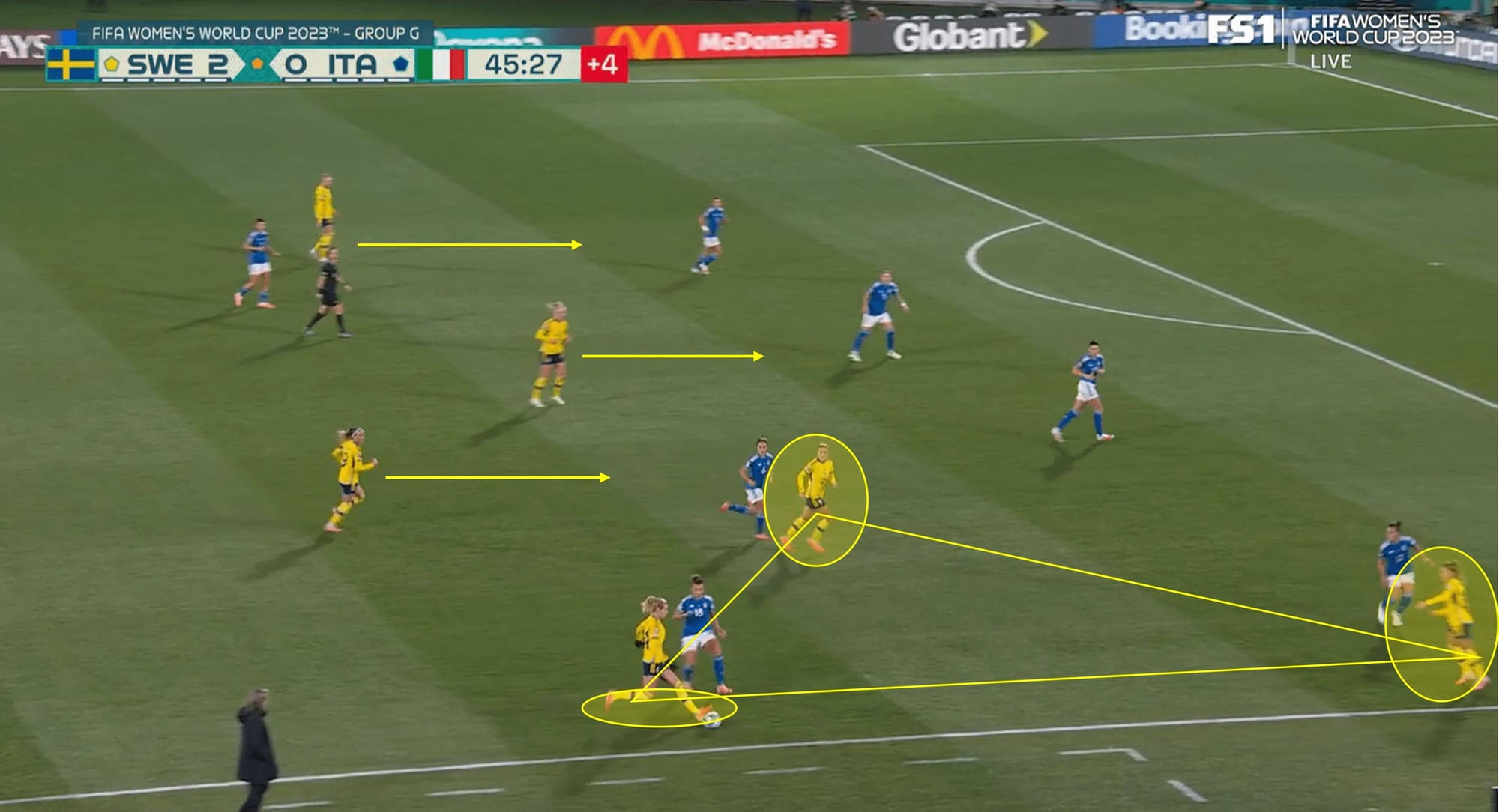
Looking first at Sweden’s third goal against Italy, as it holds elements that we might see in South Africa’s attacking play, it will be interesting to see if RSA can exploit the same issues or if Italy can make a quick fix to make themselves harder to penetrate from wide areas. The move begins with Sweden already having a high attacking presence – something we do see from time to time in South Africa’s tactics, but more important is the overloading on the right flank.
Three players close together on the flank was more than effective in breaking down Italy’s midfield and defensive units. While Sweden deserve credit for simply fantastic football, they were helped by some lacklustre defending from Italy. In the image above, the pressure on the ball did not come soon enough, and the Sweden player at the point of the marked triangle wasn’t even marked goal-side, allowing her to be much more dangerous.
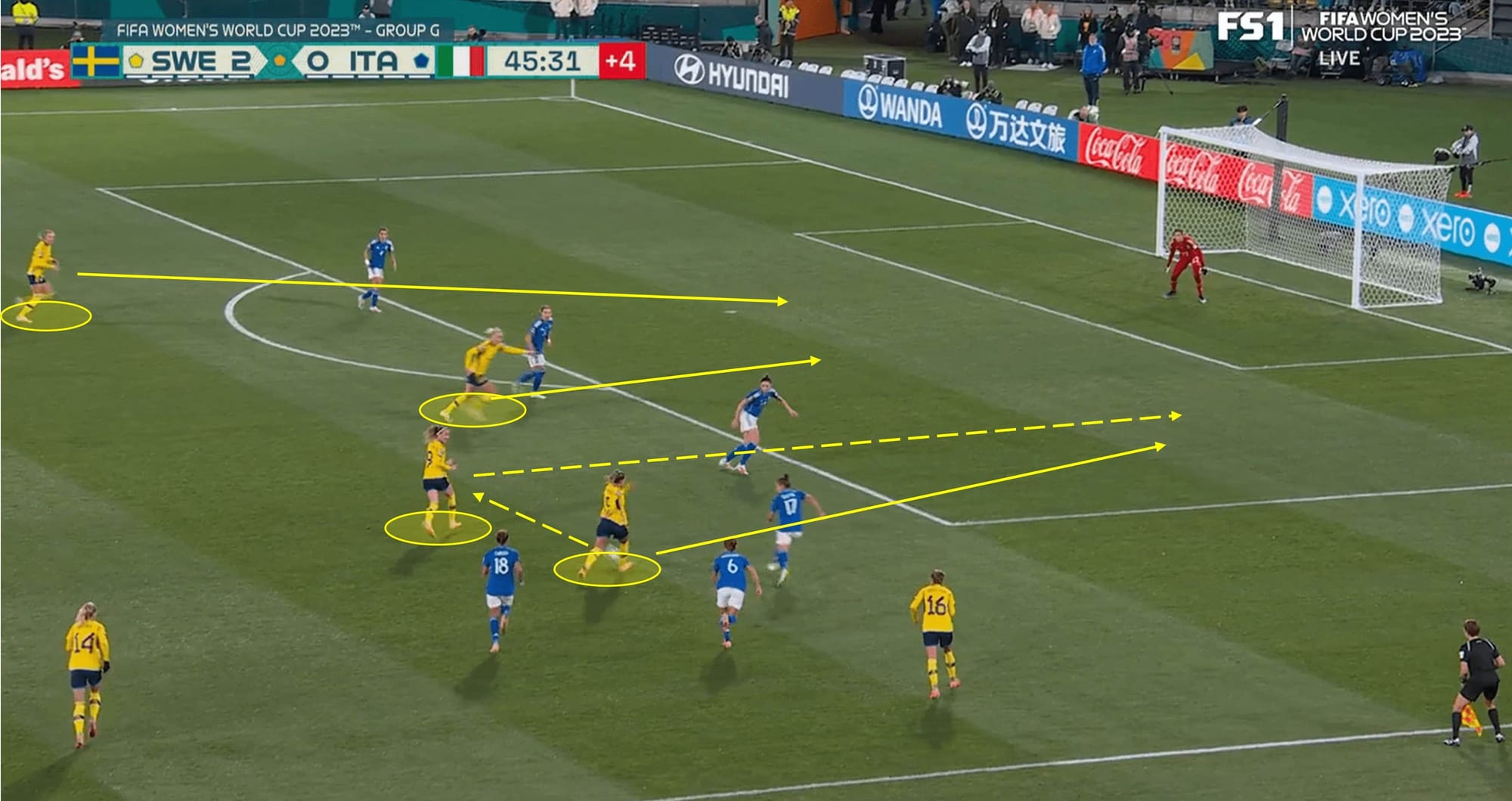
The attack continued with some exquisite combination play from Sweden that left Italy scrambling. The off-the-ball movements made by the two players not involved in the original build-up play on the right flank added another dangerous dimension to the attack, including a late run which is also an essential part of RSA’s tactics, as covered by David Astill in his tactical preview of them in last month’s magazine issue.
The combination play continued with a one-two play executed as Sweden approached the box – attacking at speed from the flanks with high attacking presence and passing combinations is clearly something Italy struggled with defending, and as David’s preview stated, RSA like building attacks into wide areas while also utilising player combinations. He also stated that South Africa is likely to treat their possession with more caution and patience. Still, there is a strong chance that they increase their attacking intensity to try and exploit Italy’s issues in midfield.
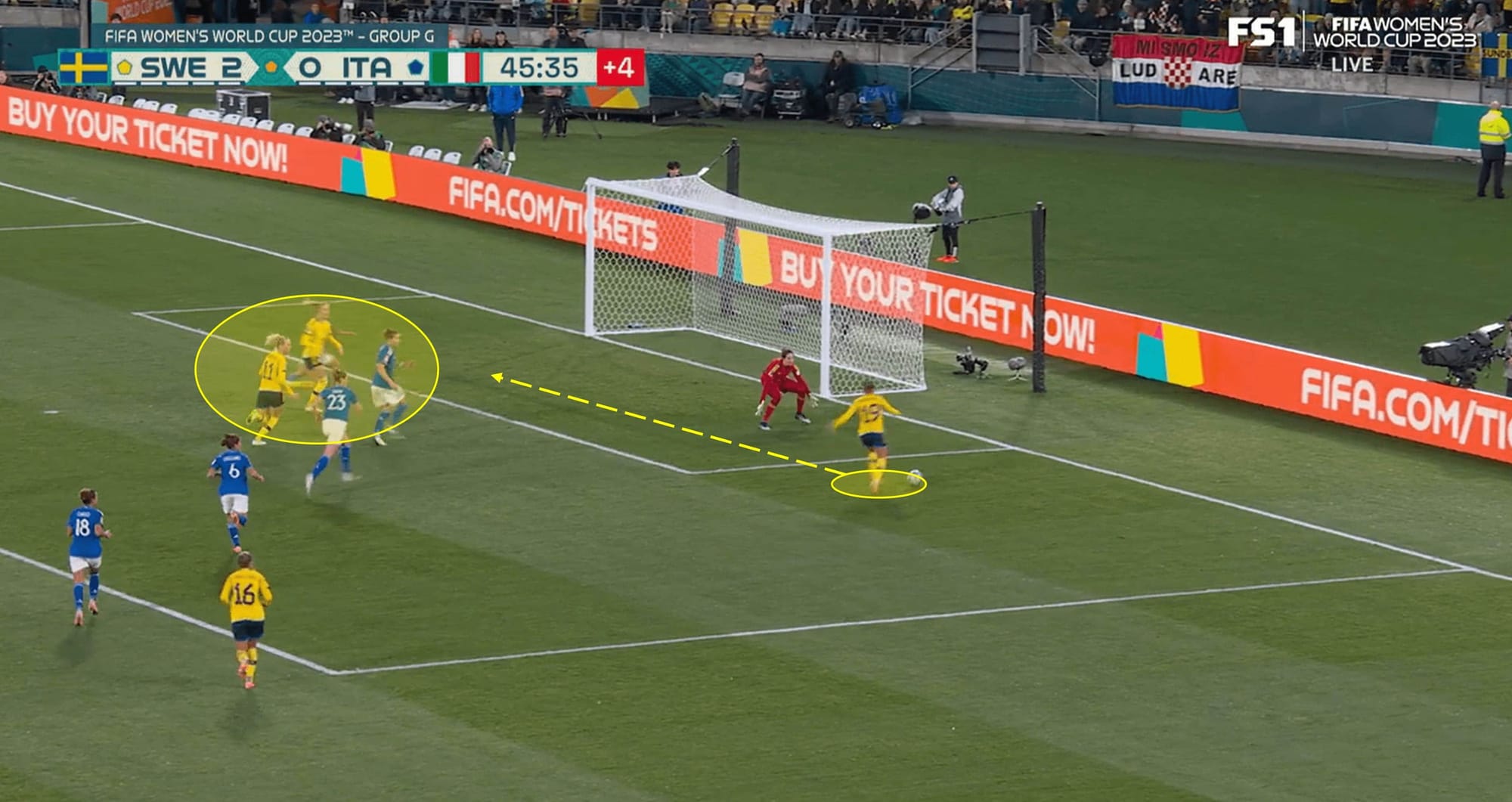
The move culminated in Johanna Rytting Kaneryd receiving the return pass in the aforementioned one-two play, and the winger fizzed a ball across the six-yard box, which was eventually finished to make it 3-0. South Africa like to build their attacks out wide patiently as it allows teammates to take up a supporting position inside the box so RSA can play into the box – they like to try and work their way inside the penalty area through ground passes, not just crosses.
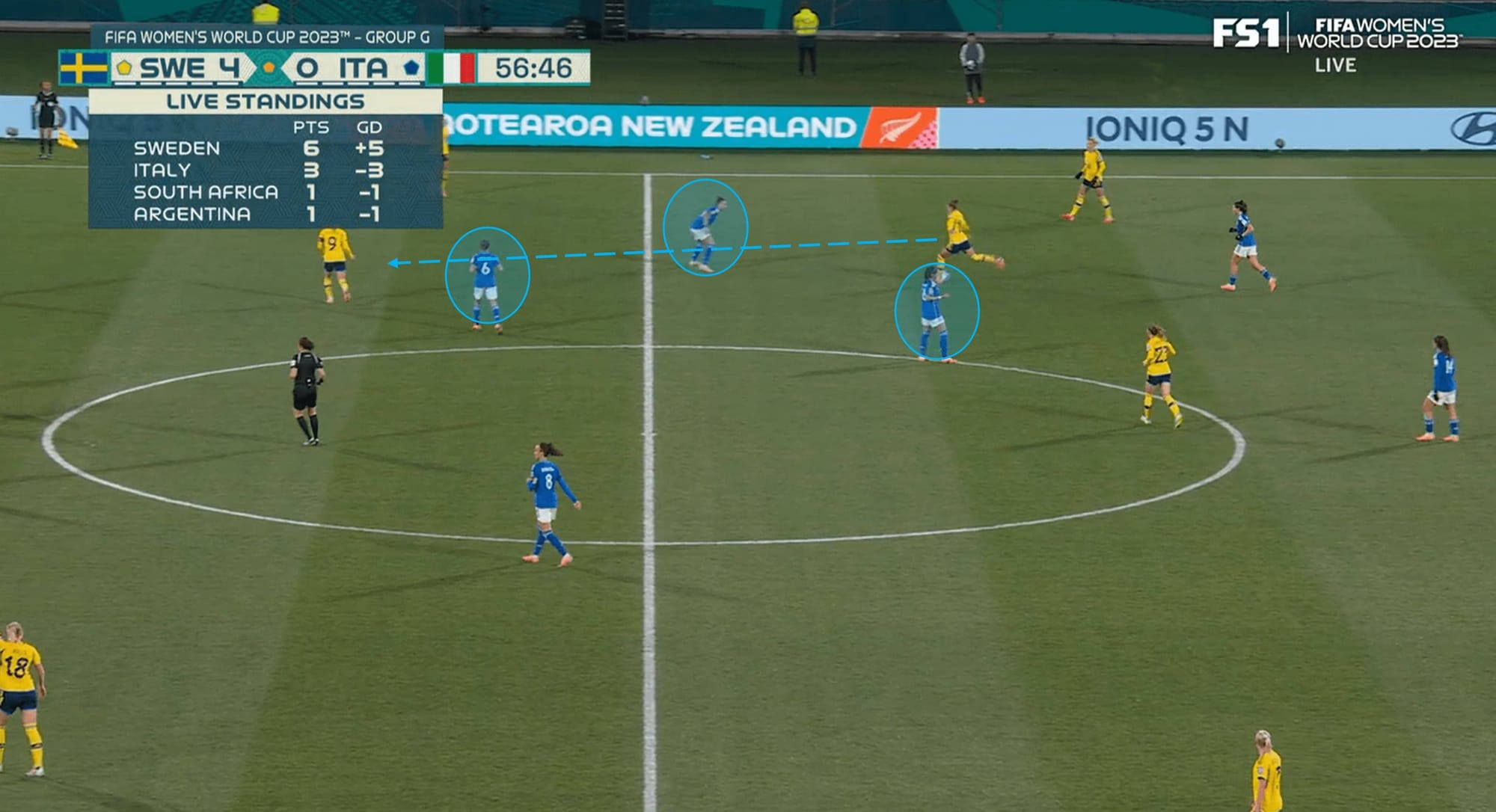
Flexibility on where you focus your possession is essential – if a team constantly looks to attack the same areas, the opposition will soon catch on and find a way to stop it. Thankfully for RSA, their patient, cautious approach to build-up play means they usually have good support positioned in several areas, not just on the flanks. In the team news section, we mentioned that Italy struggled in midfield, particularly in the defensive midfield area, allowing Sweden to play line-breaking passes and enabling quick progress up the pitch.
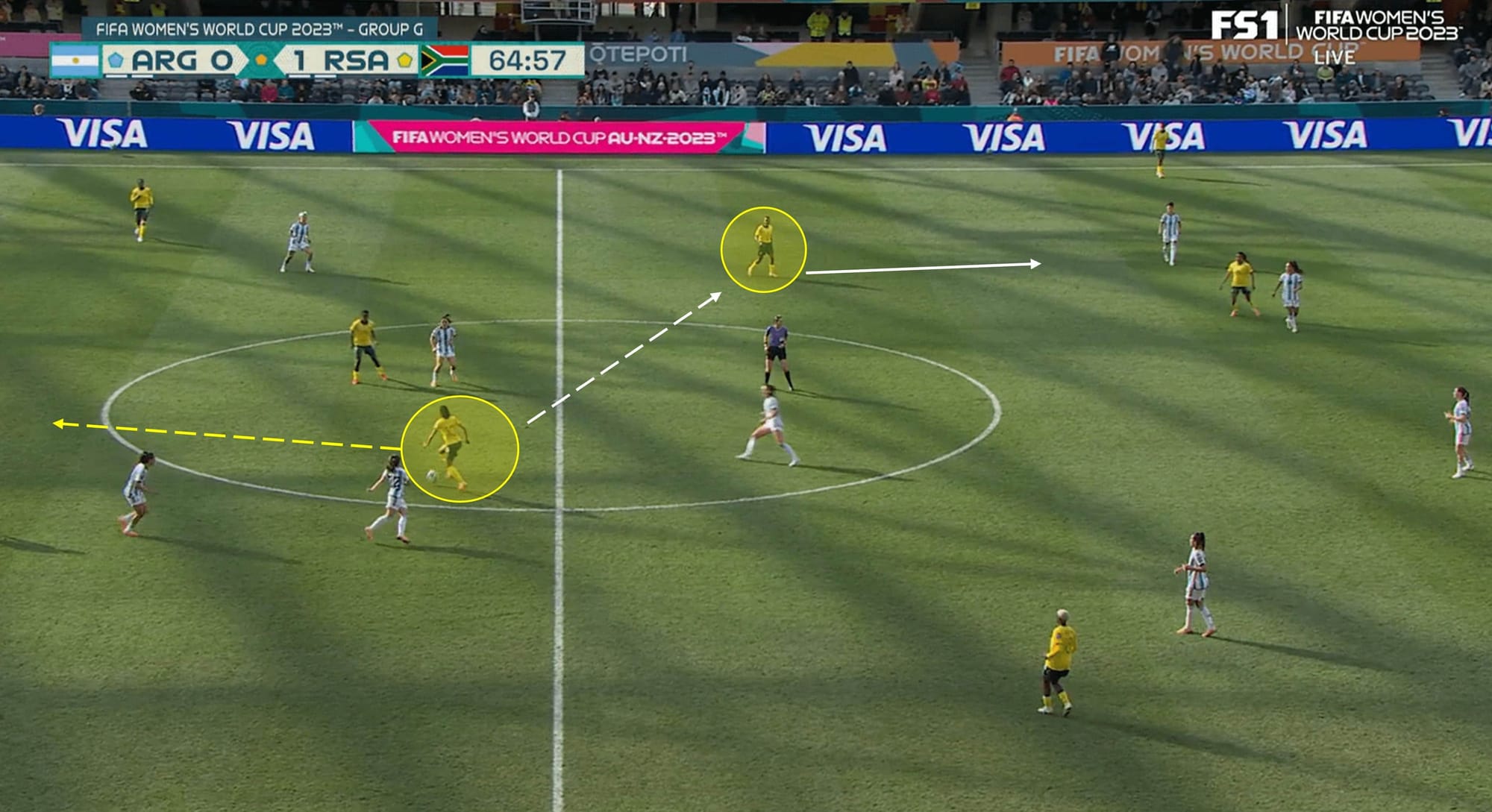
South Africa could take note of this and look to exploit, although they sometimes seem to avoid similar options in their own play. Take the example against Argentina above; the midfielder had a clear line to pass into a dangerous area of midfield – had she received the ball in that area, she would’ve had the option to either drive at Argentina’s defensive or shift the ball out to the left flank and continue the attack. Instead, they opted to slow play down and play the pass back to the defensive unit.
The reason behind this could be one of two things. Firstly, it could have been done in line with trying to protect the lead against Argentina; perhaps they were under tactical instruction to slow the pace of the game down when given a chance. Another option is that the player simply did not see the advanced option – although this is unlikely! Either way, if RSA want to attack with more intensity than usual against Italy, they must be willing to take some risk in their play, which includes forward passes in critical moments.
South Africa in attacking transitions
Something that has been an important weapon in South Africa’s arsenal in this competition is their decision-making & execution in attacking transitions. Don’t expect the following analysis to paint a picture of a team who constantly uses a high press to create transition moments where they counterattack immediately, as RSA like to remain patient and relaxed on the ball during transitions a lot of the time. That’s okay, but there may be a need to increase their attacking intent against Italy in these areas.
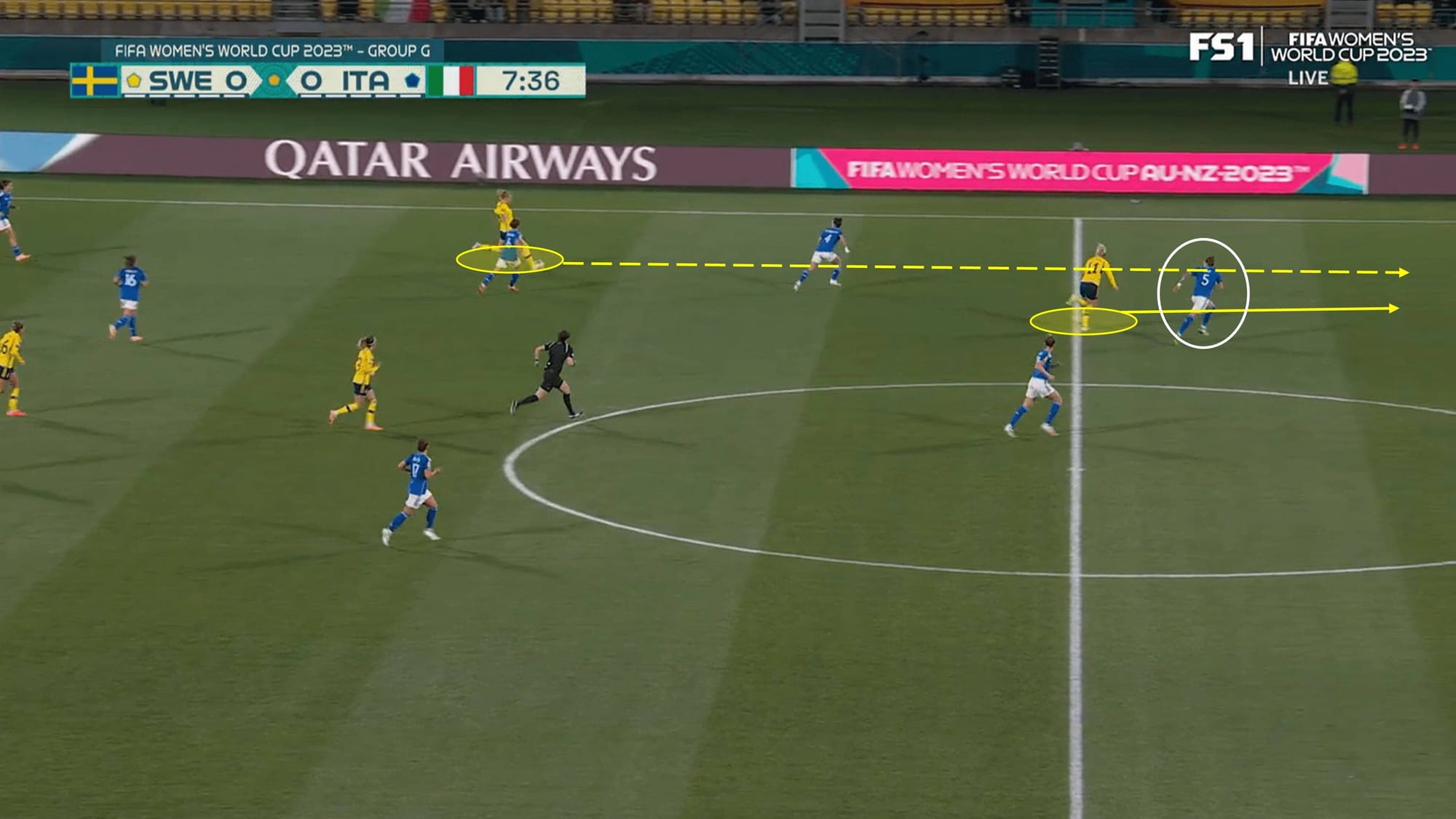
Italy’s number five, Elena Linari (circled above), showed signs of a real struggle for pace against Sweden. The example above was the most prominent example of that – she already has a yard or so on her Swedish counterpart, but once the pass into space came, she was easily beaten for pace and thus giving Sweden a chance to take their attack to the final third.
Hitting Italy in these moments of transition, when their full-backs are too far forward to make any real defensive contribution, could be critical for RSA, as they will likely win the 1v1 pace race against Italy’s central defenders.
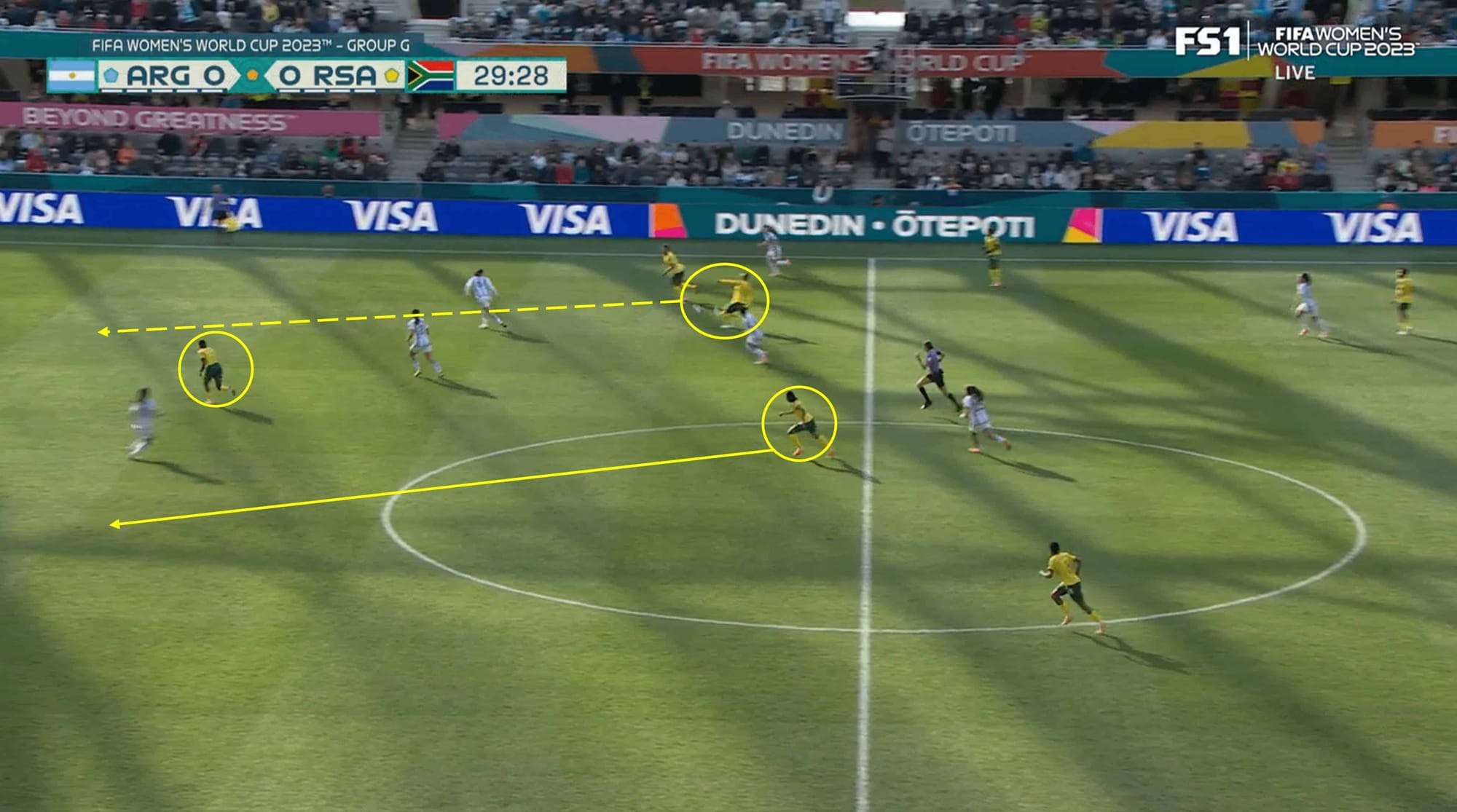
South Africa’s first goal against Argentina shared similarities to the previous example, so we think these types of attacking transitions could play an important role in Ellis’ tactics in the final group stage fixture. As we said earlier, South Africa won’t opt to counterattack every time during transition, but they have shown that they can effectively do so.
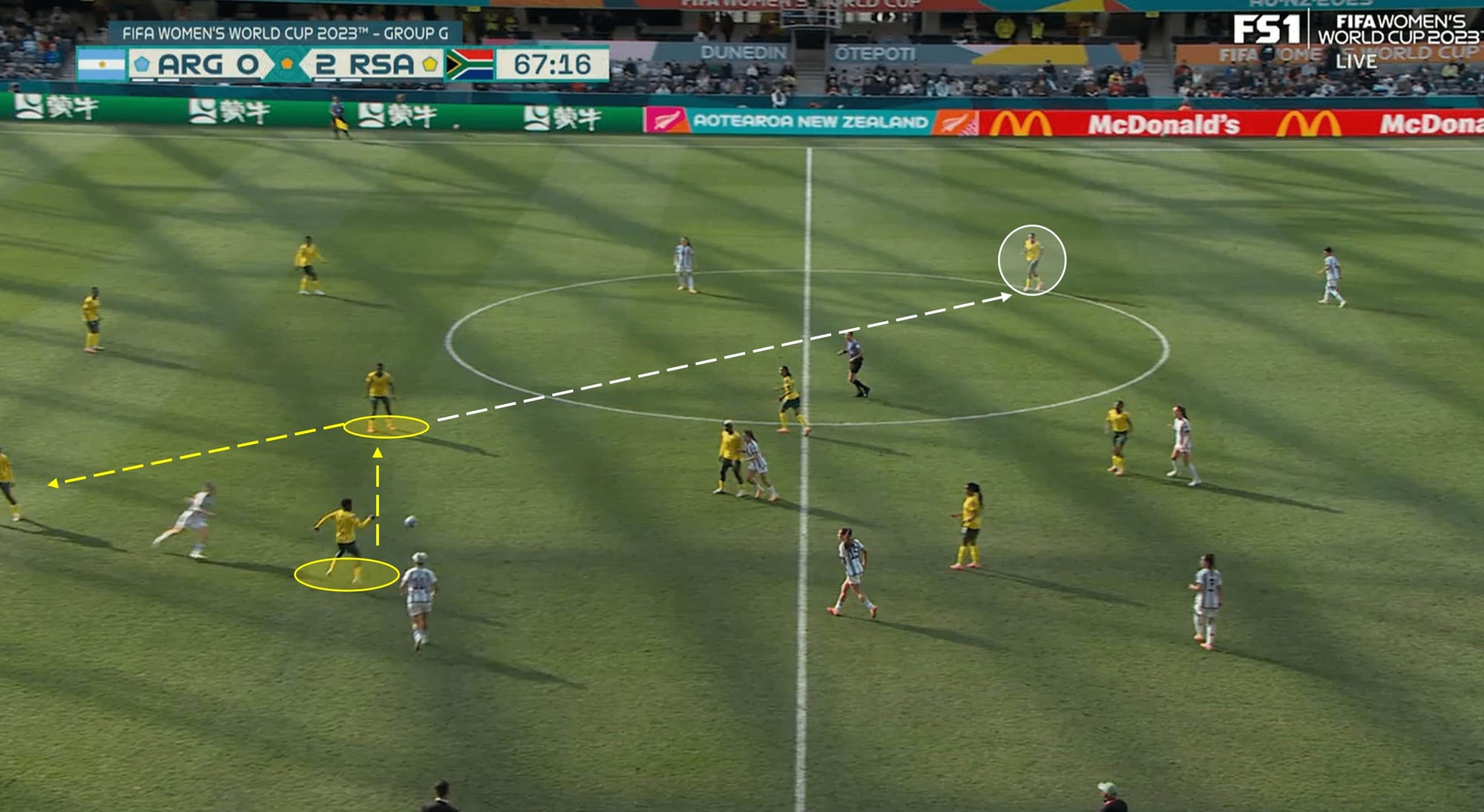
This example shows us how RSA have typically been in transitions. Breaking it down, we start with the close support and its positioning, as it almost always shares the same traits.
Remembering their patient approach in possession, which often features lateral passing, they often have a player close by in transition areas so they can quickly bounce the ball out to that close option, relieving any pressure on the player on the ball.
This is where we see similar behaviour in midfield to an earlier example where they ignore forward passing options, instead looking to slow possession down and regain a total grip on the game, looking to push the opposition back.
Conclusion
Italy’s horror defeat to Sweden does not make them easy pickings for South Africa, but Desiree Ellis’ side have showcased enough attacking ability so far to offer a threat to Italy’s World Cup status. South Africa have only made it to one World Cup previously – 2019, where they finished bottom of their group.
This year, they have a real chance of progressing to the knockouts, but it comes down to two primary factors: how Italy recover from a heavy defeat and whether South Africa can make slight tweaks to their attacking play to hurt Italy.

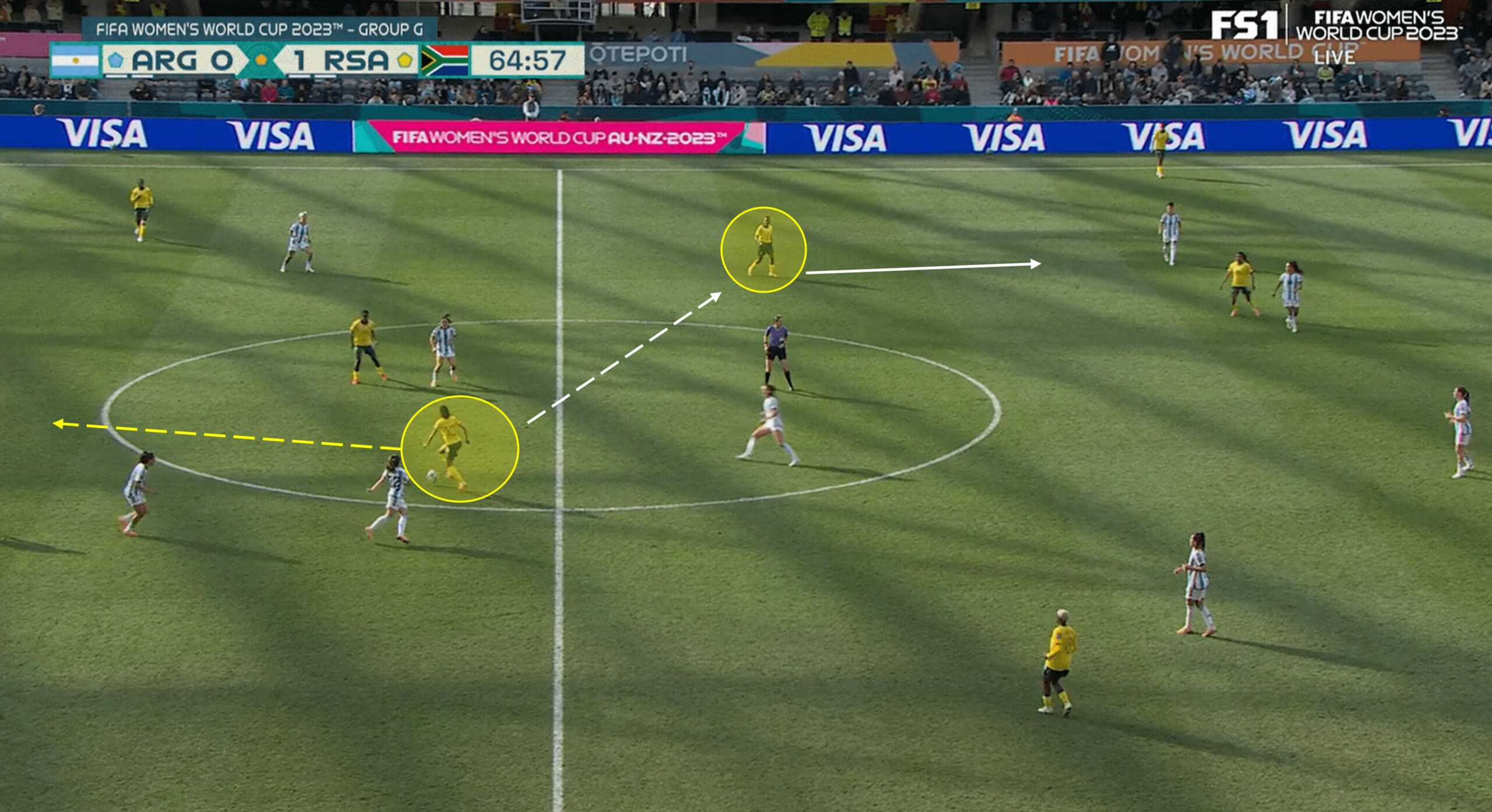




Comments